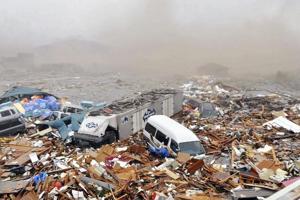
Houses and cars are swept out to sea in Kesennuma city March 11, 2011.The biggest earthquake to hit Japan since records began 140 years ago struck the northeast coast on Friday, triggering a 10-metre tsunami that swept away everything in its path, including houses, ships, cars and farm buildings on fire.
Credits: REUTERS/YOMIURI Courtesy AlertNet.org
Caritas Japan has launched a national donation campaign and is working closely with dioceses to support those affected by the earthquake and tsunami which hit the country on 11th March.
Over 1,800 people are confirmed dead so far and many thousands more are missing following the disaster. The 8.9 magnitude earthquake is the strongest in Japan’s history. But it was the 30ft high tsunami which caused much of the devastation, washing away towns and infrastructure.
The country is currently dealing with a nuclear crisis after the tsunami destabilised several nuclear plants, raising the risk of accidents and radiation exposure to the surrounding population.
“We have received so many emails from all continents, filled with words of compassion and prayer. We are very grateful for this solidarity. We believe that aid activity is needed, but prayer is also important in such a situation,” said Bishop Isao Kikuchi, president of Caritas Japan.
Caritas Japan is in contact with the diocese of Sendai, one of the worst affected areas. It is preparing to start providing relief with a focus on those with no access to public services.
Caritas Japan does not intend to develop a large-scale response operation to this disaster, but it will be working closely with the affected dioceses and other organisations to support vulnerable people affected by this disaster. Caritas Japan says it will concentrate its effort much more for the rehabilitation phase with a big focus on providing moral and psychological support to those deeply affected by the disaster.
The Japanese army has taken the lead in relief efforts. Rescue workers are still digging through rubble looking for bodies after the tsunami flattened coastal towns.
People are still facing strong aftershocks as well as shortages of food and water. Many people are without shelter.
Fears that the tsunami would overwhelm other Pacific islands were unfounded and no real damage or injury was reported elsewhere in the region.
Please call Michelle Hough on +39 06 69879721 or +39 334 2344136 or [email protected] with any requests.
